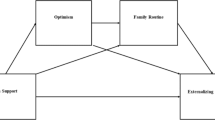Abstract
As part of a larger program of research on the nature of adolescents' relationships with very important nonparental adults (hereafter referred to as “VIPs”), a community sample of 243 eleventh graders (mean age = 16.6 years) was surveyed, and a subgroup of 55 adolescents and their VIPs were interviewed about the nature and quality of their relationships. Results showed that (a) adolescent–VIP relationships were a normative component of adolescent development, not a result of problems in adolescents' lives; (b) adolescent–VIP relationships were generally of high quality (e.g., high support, low conflict, and high mutuality); (c) there were significant differences between kin and nonkin VIPs in terms of the duration of relationships and frequency of contact, but not in the quality of relationships; and (d) VIPs whom adolescents designated as extremely important were distinguished from other VIPs in terms of providing a higher level of social support and a higher frequency of contact. Theoretical and practical implications of these findings are discussed.
Similar content being viewed by others
REFERENCES
Barrera, M., Jr., Sandler, I. N., & Ramsey, T. B. (1981). Preliminary development of a scale of social support: Studies on college students. American Journal of Community Psychology, 9, 435-447.
Berndt, T. J. (1996). Transitions in friendship and friends' influence. In J. A. Graber, J. Brooks-Gunn, & A. C. Petersen (Eds.), Transitions through adolescence: Interpersonal domains and context (pp. 57-84). Mahwah, NJ: Erlbaum.
Berndt, T. J., & Hoyle, S. G. (1985). Stability and change in childhood and adolescent friendships. Developmental Psychology, 21, 1007-1015.
Burton, L. M. (1996). Age norms, the timing of family role transitions, and intergenerational caregiving among aging African American women. Gerontologist, 36, 199-208.
California Department of Education. (1999). Fiscal, demographic, and performance data on California's K-12 schools. Retrieved from www.ed-data.k12.ca.us
Cowen, E. L., & Work, W. C. (1988). Resilient children, psychological wellness, and primary prevention. American Journal of Community Psychology, 16, 591-607.
Dornbusch, S. M., Carlsmith, J. M., Bushwall, S. J., Ritter, P. L., Leiderman, H., Hastorf, A. H., et al. (1985). Single parents, extended households, and the control of adolescents. Child Development, 56, 326-341.
Erikson, E. (1956). Childhood and society. New York: Norton.
Freedman, M. (1993). The kindness of strangers. San Francisco: Jossey-Bass.
Garmezy, N. (1985). Stress-resistant children: The search for protective factors. Journal of Child Psychology and Psychiatry 4(Suppl.), 213-233.
Garmezy, N. (1987). Stress, competence, and development: Continuities in the study of schizophrenic adults, children vulnerable to psychopathology, and the search for stressresistant children. American Journal of Orthopsychiatry, 57, 159-174.
Greenberger, E., Chen, C., & Beam, M. (1998). The role of “very important” nonparental adults in adolescent development. Journal of Youth and Adolescence, 27, 321-343.
Klaw, E. L., & Rhodes, J. E. (1995). Mentor relationships and the career development of pregnant and parenting African American teenagers. Psychology of Women Quarterly, 19, 551-562.
Litwak, E., & Szelenyi, I. (1969). Primary group structures and their functions: Kin, neighbours, and friends. American Sociological Review, 34, 465-481.
Luthar, S. S., & Zigler, E. (1991). Vulnerability and competence: A review of research on resilience in childhood. American Journal of Orthopsychiatry, 61, 6-22.
Morgan, M., & Grube, J. W. (1991). Closeness and peer group influence. British Journal of Social Psychology, 30, 159-169.
Paikoff, R. L., & Brooks-Gunn, J. (1991). Do parent-child relationships change during puberty? Psychological Bulletin, 110, 47-66.
Rhodes, J. E., Ebert, L., & Fischer, K. (1992). Natural mentors: An overlooked resource in the social networks of young, African American mothers. American Journal of Community Psychology, 20, 445-461.
Rutter, M. (1987). Psychosocial resilience and protective mechanisms. American Journal of Orthopsychiatry, 57, 316-331.
Steinberg, L. (1990). Autonomy, conflict, and harmony in the family relationship. In S. S. Feldman & G. R. Elliott (Eds.), At the threshold: The developing adolescent (pp. 255-276). Cambridge, MA: Harvard University Press.
Taylor, R. D., Casten, R., & Flickenger, S. M. (1993). Influence of kinship social support on the parenting experiences and psychosocial adjustment of African-American adolescents. Developmental Psychology, 29, 382-388.
Tierney, J. P., Grossman, J. B., & Resch, N. L. (1995). Making a difference: An impact study of Big Brothers/Big Sisters. Philadelphia: Public/Private Ventures.
Wellman, B., & Wortley, S. (1990). Different strokes from different folks: Community ties and social support. American Journal of Sociology, 96, 558-588.
Werner, E. E., & Smith, S. (1982). Vulnerable but not invincible: A study of resilient children. New York: McGraw-Hill.
Author information
Authors and Affiliations
Rights and permissions
About this article
Cite this article
Beam, M.R., Chen, C. & Greenberger, E. The Nature of Adolescents' Relationships with Their “Very Important” Nonparental Adults. Am J Community Psychol 30, 305–325 (2002). https://doi.org/10.1023/A:1014641213440
Issue Date:
DOI: https://doi.org/10.1023/A:1014641213440




